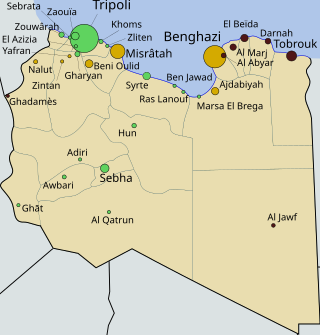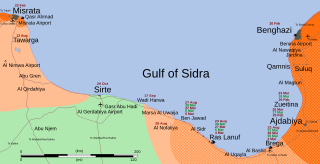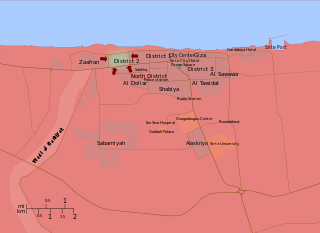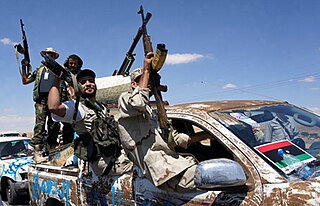
Sirte, also spelled Sirt, Surt, Sert or Syrte, is a city in Libya. It is located south of the Gulf of Sirte, almost right in the middle between Tripoli and Benghazi. It is famously known for its battles, ethnic groups and loyalty to former Libyan ruler Muammar Gaddafi. Due to developments in the First Libyan Civil War, it was briefly the capital of Libya as Tripoli's successor after the Fall of Tripoli from 1 September to 20 October 2011. The settlement was established in the early 20th century by the Italians, at the site of a 19th-century fortress built by the Ottomans. It grew into a city after World War II.
Ras Lanuf is a Mediterranean town in northern Libya, on the Gulf of Sidra in Tripolitania. The town is also home to the Ra's Lanuf Refinery, completed in 1984, with a crude oil refining capacity of 220,000 bbl/d (35,000 m3/d). The oil refinery is operated by the Ra's Lanuf Oil & Gas Processing Company, a subsidiary of the state-owned National Oil Corporation. Additionally, the city houses the Ra's Lanuf petrochemical complex – a major oil terminal – and oil pipelines: the Amal–Ra's Lanuf, the Messla–Ra's Lanuf, and the Defa-Ra's Lanuf pipeline.

The Libyan Civil War began on 17 February 2011 as a civil protest and later evolved into a widespread uprising. By mid-August, anti-Gaddafi forces effectively supported by a NATO-led international coalition were ascendant in Tripolitania, breaking out of the restive Nafusa Mountains in the south to mount an offensive toward the coast and advancing from Misrata on loyalist-held cities and villages from the north and east.

The First Battle of Brega was fought during the Libyan Civil War. It began when pro-Gaddafi government troops attacked the city, held by the National Transitional Council, in the early hours of 2 March 2011.
The Battle of Ras Lanuf was a two-phase battle in early to mid-March 2011 during the Libyan Civil War between forces loyal to Libyan leader Muammar Gaddafi and those loyal to the National Transitional Council. Both forces sought control of the town of Ras Lanuf. The first phase of confrontation followed two days after the First Battle of Brega which occurred in the town Brega, roughly 130 kilometres (81 mi) to the east of Ras Lanuf. After conquering the town on 4 March, the rebels pushed further west to attack Sirte but they were driven back by government forces and on 11 March, government troops reconquered most of Ras Lanuf.
Bin Jawad, also known as Bin Jawwād, Bin Quwad is a town with estimated 8,488 inhabitants in the Sirte District in Libya. It is approximately halfway between Benghazi and Misrata. The nearest settlements are Nofaliya, which is about 20 km to the west, and the port of Sidra, which is about 30 km to the southeast of Bin Jawad.
The Second Battle of Brega took place during the Libyan Civil War. Eleven days earlier, anti-Gaddafi forces had beaten back an attempt by loyalist forces to take the town on 2 March 2011, in the First Battle of Brega. Following that battle, rebel forces advanced along the Libyan Coastal Highway, taking the towns of Ra's Lanuf and Bin Jawad. However, after the Battle of Bin Jawad and the Battle of Ra's Lanuf, government troops retook all of the lost territory and were once again threatening Brega by mid-March.

The First Gulf of Sidra offensive was the second major rebel offensive of the Libyan Civil War. It was mounted by anti-Gaddafi forces immediately after their victory in the Battle of Ajdabiya. The offensive was meant to have the rebel forces quickly reach Gaddafi's hometown of Sirte.
The Battle of Bin Jawad took place in early March 2011 during the Libyan Civil War between forces loyal to Libyan leader Muammar Gaddafi and anti-Gaddafi forces for control of the town of Bin Jawad.
The Fourth Battle of Brega was a battle in July and August 2011, during the Libyan Civil War, between forces loyal to Muammar Gaddafi and forces of the Libyan opposition for control of the strategic town of Brega and its oil port.
The Second Battle of Zawiya or Zawia took place during the Libyan Civil War between rebel anti-Gaddafi forces and forces loyal to Muammar Gaddafi for control of the Tripolitania city of Zawia.

The Libyan Civil War began on 15 February 2011 as a chain of civil protests and later evolved into a widespread uprising against the regime of Muammar Gaddafi. On 25 February, most of eastern Libya was reported to be under the control of protesters and rebel forces. Gaddafi remained in control of the cities of Tripoli, Sirte and Sabha. By 15 March, however, Gaddafi's forces had retaken more than half a dozen lost cities. Except for most of Cyrenaica and a few Tripolitania cities the majority of cities had returned to Gaddafi government control.

The timeline of the Libyan civil war begins on 15 February 2011 and ends on 20 October 2011. The conflict began with a series of peaceful protests, similar to others of the Arab Spring, later becoming a full-scale civil war between the forces loyal to Muammar Gaddafi's government and the anti-Gaddafi forces. The conflict can roughly be divided into two periods before and after external military intervention authorized by United Nations Security Council Resolution 1973.
The Fezzan campaign was a military campaign conducted by the National Liberation Army to take control of southwestern Libya during the Libyan Civil War. During April to June 2011, anti-Gaddafi forces gained control of most of the eastern part of the southern desert region during the Cyrenaican desert campaign. In July, Qatrun changed to anti-Gaddafi control on 17 July and back to pro-Gaddafi control on 23 July. In late August, anti- and pro-Gaddafi forces struggled for control of Sabha.

The Libyan Civil War began on 15 February 2011 as a civil protest and later evolved into a widespread uprising. However, by 19 March, Libyan forces under Colonel Muammar Gaddafi were on the brink of a decisive victory over rebels in Libya's east. That day, leading NATO members acted on United Nations Security Council Resolution 1973 which authorized member states "to take all necessary measures... to protect civilians and civilian populated areas under threat of attack in the Libyan Arab Jamahiriya, including Benghazi, while excluding an occupation force".

The Second Gulf of Sidra offensive was a military operation in the First Libyan Civil War conducted by rebel anti-Gaddafi forces in August and September 2011 to take control of towns along the Gulf of Sidra in an effort to surround Muammar Gaddafi's hometown of Sirte, which was held by pro-Gaddafi forces. The offensive ended on 20 October, with the capture and execution of Muammar Gaddafi and his son Mutassim Gaddafi, along with former defense minister Abu-Bakr Yunis Jabr. The Gaddafi loyalists in the area were finally defeated when NTC fighters captured Sirte.
The raid onRas Lanuf was a hit-and-run attack carried out in the early morning of 12 September 2011 by two groups of fighters loyal to Muammar Gaddafi in an apparently coordinated effort to disrupt oil refinery and export operations in the National Transitional Council-administered port town of Ra's Lanuf, Libya, during the Libyan Civil War.

The Battle of Sirte was the final and most decisive battle of the First Libyan Civil War, beginning when the National Liberation Army attacked the last remnants of the Libyan army still loyal to Muammar Gaddafi in his hometown and designated capital of Sirte, on the Gulf of Sidra. As of September 2011, Sirte and Bani Walid were the last strongholds of Gaddafi loyalists and the National Transitional Council hoped that the fall of Sirte would bring the war to an end. The battle and its aftermath marked the final collapse of the four-decade Gaddafi regime. Both Gaddafi and his son, Mutassim, were wounded and captured, then tortured and killed in custody less than an hour later. The month-long battle left Sirte almost completely in ruins, with many buildings damaged or totally destroyed.

The Battle of Bani Walid was a military operation in the Libyan Civil War conducted by anti-Gaddafi forces in September and October 2011, in an effort to take control of the desert city of Bani Walid from pro-Gaddafi forces. It began following days of force buildup on the part of the attackers, as well as skirmishes around the city.

The 2011 Libyan Civil War began on 17 February 2011 as a civil protest and later evolved into a widespread uprising. After a military intervention led by France, the United Kingdom, and the United States on 19 March turned the tide of the conflict at the Second Battle of Benghazi, anti-Gaddafi forces regrouped and established control over Misrata and most of the Nafusa Mountains in Tripolitania and much of the eastern region of Cyrenaica. In mid-May, they finally broke an extended siege of Misrata.







